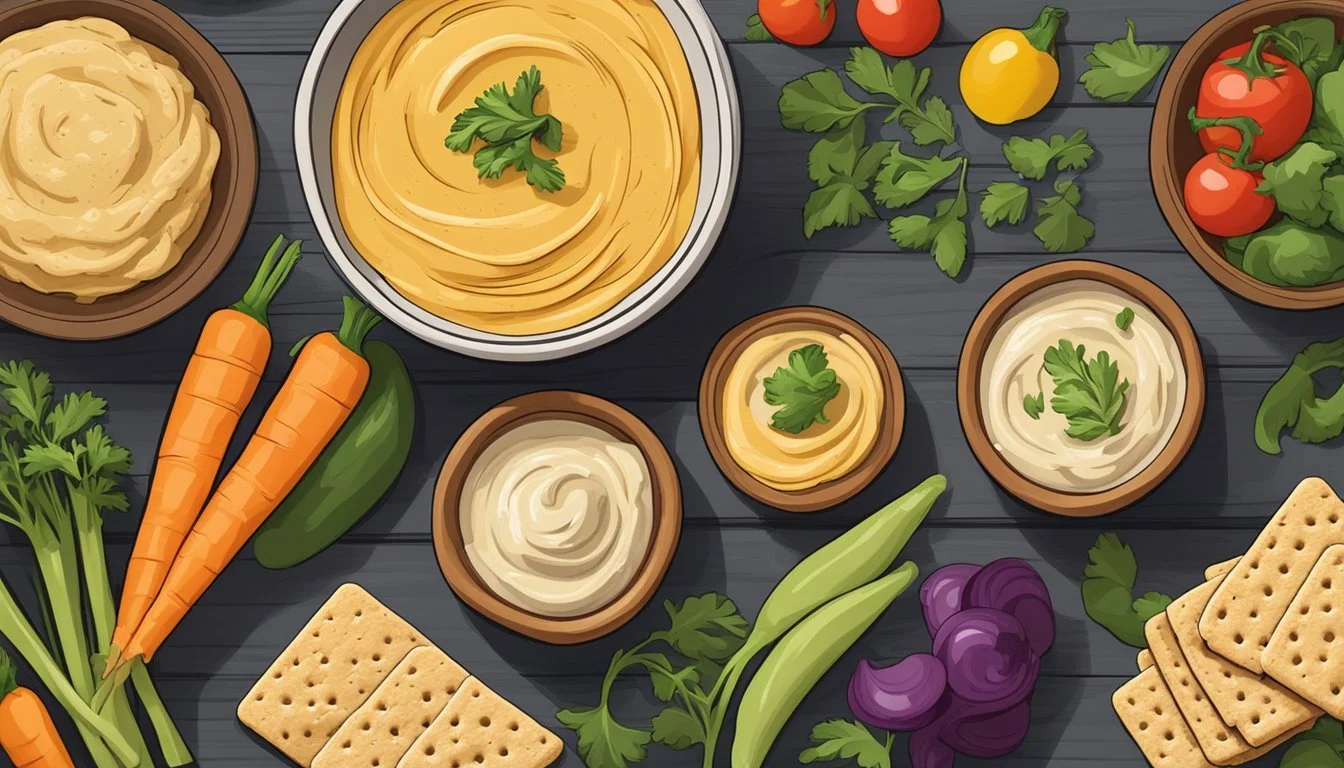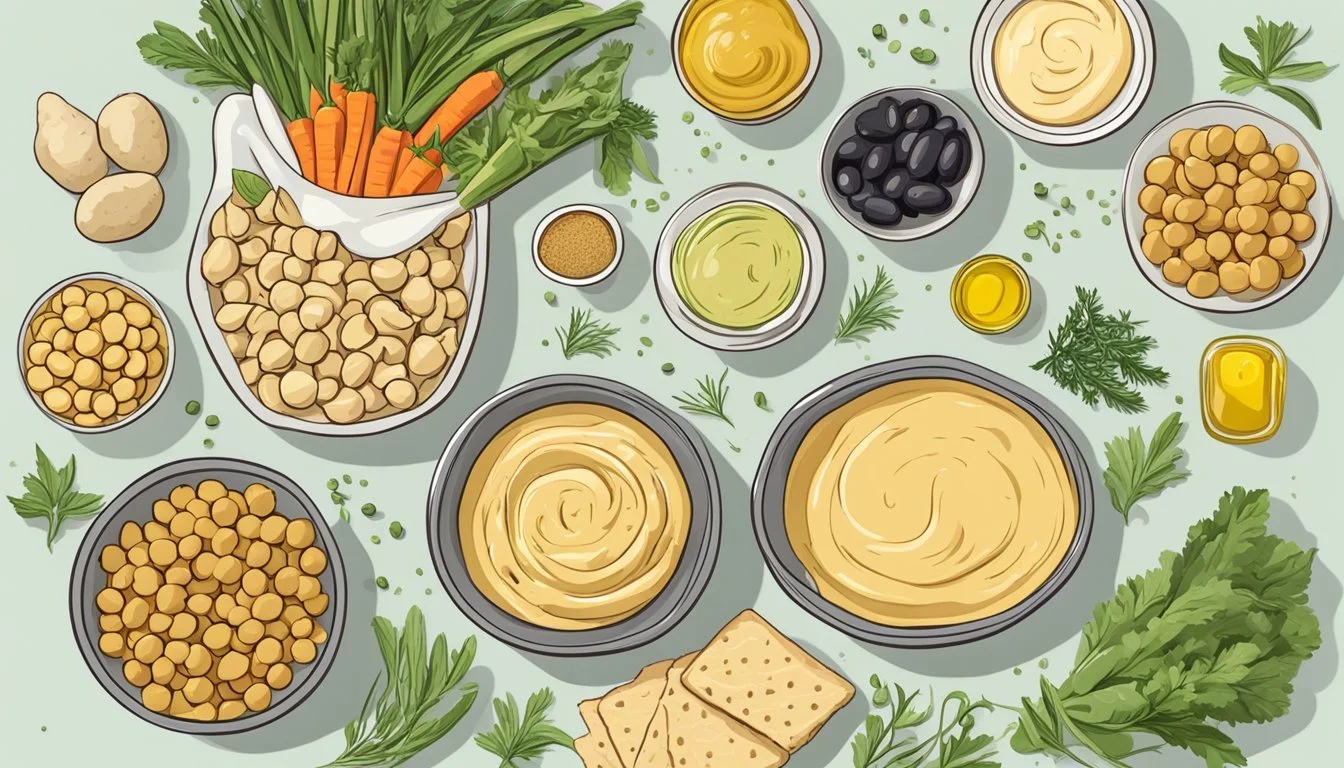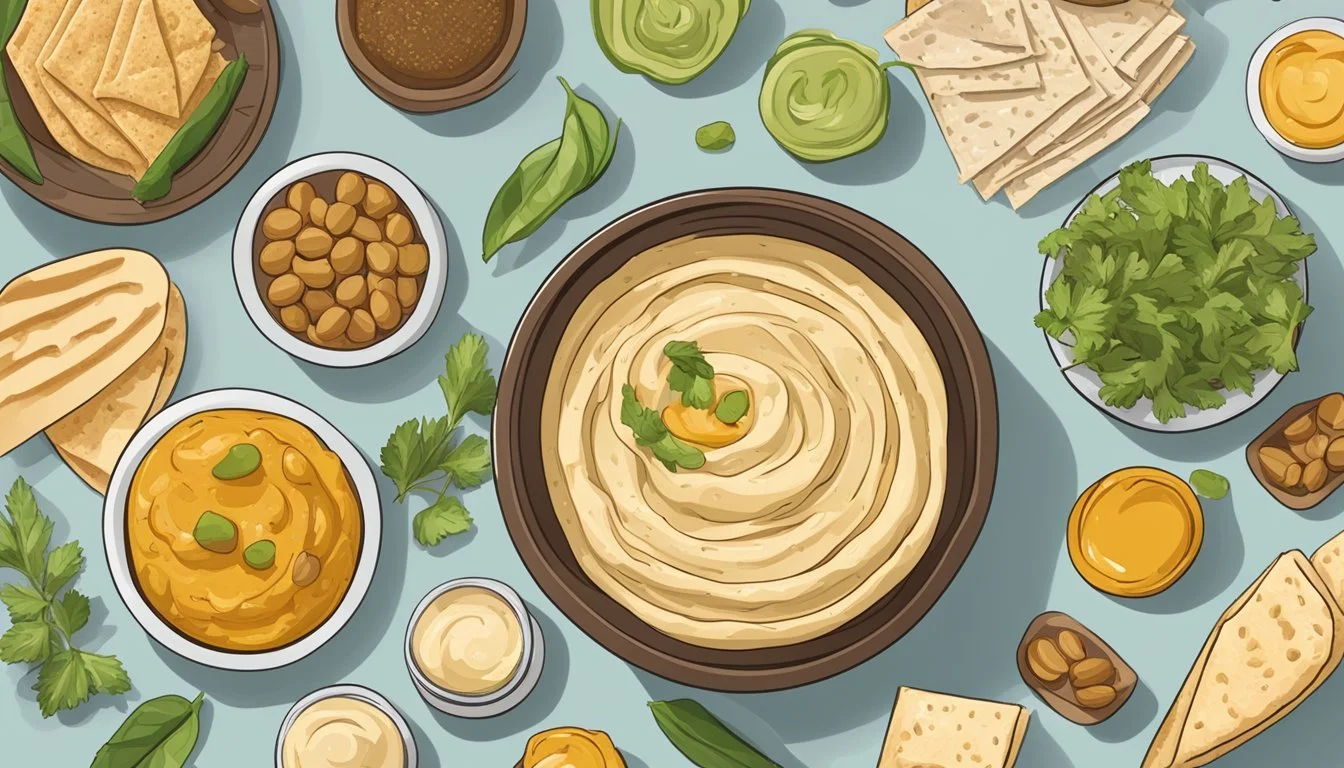Is Hummus Gluten-Free?
Unveiling the Truth About This Popular Dip
Hummus is a popular Middle Eastern spread made from ground chickpeas, tahini, olive oil, lemon juice, garlic, and salt. These ingredients are inherently gluten-free, offering a safe option for individuals with celiac disease or gluten sensitivity. As a staple in many diets around the world, hummus is celebrated not just for its savory flavor but also for its versatility and the health benefits it provides, being rich in protein and fiber.
Despite the naturally gluten-free components of traditional hummus recipes, variations in production methods can introduce the risk of cross-contamination with gluten. For example, if a facility processes wheat or other gluten-containing products alongside hummus, there is a potential for gluten to be present in the final product. This concern emphasizes the importance for consumers to examine labels carefully, particularly when dealing with flavored hummus or lesser-known brands that may not have strict cross-contamination controls in place.
For those who need to ensure their diet remains strictly gluten-free, looking for certification labels or choosing brands with transparent and dedicated gluten-free manufacturing processes is critical. Renowned gluten-free hummus brands such as Sabra and Athenos make it simpler for shoppers to confidently enjoy hummus without the worry of gluten exposure. However, when in doubt, consumers are advised to reach out directly to manufacturers to verify gluten-free claims and production practices.
What Is Hummus?
Hummus is a versatile and nutritious spread or dip that has captured the palates of food lovers worldwide. This section delves into its origins and key components.
Origins and Popularity
Hummus has its roots in the Middle Eastern culinary tradition. This region is known for an array of dishes that feature bold flavors and healthful ingredients. Hummus has gained immense popularity globally, not only for its rich, creamy taste but also for its reputation as a health-conscious choice. It is a staple in Middle Eastern cuisines and has been widely embraced by various cultures for its simplicity and adaptability to different tastes and dietary needs.
Classic Hummus Ingredients
The signature smooth texture and earthy taste of classic hummus come from its basic ingredients:
Chickpeas: The primary component, providing a creamy base and protein content.
Tahini: A paste made from ground sesame seeds, giving hummus its unique flavor.
Olive Oil: Adds richness and contributes to the smooth consistency.
Lemon Juice: Infuses a bright tanginess.
Garlic: Lends a subtle heat and depth of flavor.
Salt: Enhances all the flavors.
Occasionally, cumin is added for an extra layer of warmth and complexity. Water is also essential to adjust the hummus to the desired consistency. These ingredients are blended together until a smooth paste is formed, ready to be garnished or customized with additional flavors.
Gluten-Free Diet Basics
Understanding the components and benefits of a gluten-free diet is essential for those managing celiac disease or gluten sensitivities, as well as for individuals choosing this diet for its potential health advantages.
What Is Gluten?
Gluten is a family of proteins predominantly found in wheat, barley, and rye. It's responsible for the elastic texture of dough, acting as a glue that holds food together, which can be harmful to individuals with celiac disease or gluten sensitivity. Adherence to a gluten-free diet necessitates the exclusion of these grains and any products derived from them.
Benefits of Gluten-Free Eating
Following a gluten-free diet offers several benefits, especially for those diagnosed with celiac disease or non-celiac gluten sensitivity. It can lead to a reduction in symptoms such as bloating, diarrhea, and abdominal pain. For individuals with celiac disease, it's not just beneficial – it's essential to avoid damage to the intestinal lining. Additionally, a gluten-free diet may promote digestive health and support overall wellness for some people, even in the absence of gluten intolerance.
Identifying Gluten in Foods
When checking if foods like hummus are gluten-free, it's crucial to understand how to identify gluten, read labels for content, and recognize certified gluten-free products. This section equips the reader with the necessary tools to make informed dietary choices.
Common Sources of Gluten
Gluten, a protein found in certain grains, is a common ingredient in a variety of foods. The primary grains that contain gluten are:
Wheat: Including varieties like spelt, kamut, farro, and durum, along with derivatives such as wheat flour
Barley: Often used in malt, food coloring, and soups
Rye: Common in rye bread, rye beer, and cereals
It's also important to note that products like soy sauce frequently contain wheat, and consequently gluten, unless specified otherwise.
Reading Labels for Gluten Content
Food labels are a helpful tool for those avoiding gluten. Here's what to look for:
Ingredients: Check for wheat, barley, rye, or any of their derivatives
Allergen Statements: These often indicate the presence of wheat
Cross-contamination warnings, which might appear as "may contain wheat" or "made on shared equipment"
Remember that products like flour or gluten-free pretzels must declare wheat on their labels if it is included.
Understanding 'Certified Gluten-Free'
The term 'certified gluten-free' indicates that a product has:
Undergone testing to ensure it meets strict gluten-free standards
Contains less than 20 parts per million (ppm) of gluten, a safe threshold for most with gluten sensitivity
To trust a product is safe from cross-contamination, one should look for a certification label from recognized organizations.
Making Gluten-Free Hummus
Creating gluten-free hummus at home is straightforward and ensures that individuals with gluten sensitivities can enjoy this healthy and flavorful dip without concern. The recipe revolves around commonly gluten-free ingredients and utilizes a food processor to achieve the perfect consistency.
Step-by-Step Guide
Prepare the Base: Begin by blending tahini and lemon juice in the food processor until the mixture is creamy, which typically takes about one minute.
Add Flavor and Creaminess: Include minced garlic, olive oil, and a pinch of salt to the tahini mixture and blend for 30 seconds.
Incorporate Chickpeas: Gradually add in rinsed and drained garbanzo beans (chickpeas), processing until the hummus reaches a smooth and creamy texture.
Required Equipment and Ingredients
Food Processor: Essential for creating a smooth hummus.
Ingredients: Ensure that all are certified gluten-free to avoid cross-contamination.
Lemon juice
Olive oil
Garlic
Salt
Garbanzo beans (chickpeas)
Tips for Flavor and Texture
Texture: For a creamier hummus, one can add a bit of the reserved chickpea liquid (aquafaba) during blending.
Flavor: Introduce extra ingredients such as roasted red peppers, cumin, or fresh herbs to enhance the hummus's taste profile.
Buying Store-Bought Gluten-Free Hummus
When selecting store-bought hummus, it is crucial to identify brands that offer gluten-free options and understand the implications of ingredients and additives on gluten content.
Reliable Brands and Labels
Several brands have a reputation for producing gluten-free hummus. Consumers should look for clearly marked gluten-free labels to ensure the product meets stringent standards. Notably, the following brands offer certified gluten-free hummus:
Sabra: Well-known for its variety of gluten-free hummus options.
Athenos: Offers gluten-free choices among its Mediterranean-inspired flavors.
Food Basics: A line of hummus considered safe for gluten-free diets.
Boar’s Head: Delivers gluten-free hummus that fits into a gluten-free lifestyle.
Habibi’s: Provides several gluten-free hummus selections.
Lantana: While most flavors are gluten-free, customers should read the label for specific varieties.
Fontaine Santé: Also among the recommended choices for gluten-free hummus.
Understanding Ingredients and Additives
The base ingredients in traditional hummus, such as chickpeas, tahini, lemon juice, garlic, and olive oil, are inherently gluten-free. However, when examining store bought hummus, one should be vigilant about flavorings or additional ingredients, as these can sometimes introduce gluten into the product. Here's a guideline on what to look for:
Natural Flavorings: May be a source of hidden gluten; verify their source.
Additives: Check for additives used as thickeners or stabilizers that could contain gluten.
Cross-contamination: Look for a disclaimer about shared facilities or equipment, which poses a risk for gluten exposure.
By diligently checking for a gluten-free label and reading the list of ingredients and additives, consumers can reasonably ensure the store bought hummus they select aligns with their dietary requirements.
Potential Health Benefits of Hummus
Hummus, a popular Middle Eastern spread made primarily of blended chickpeas, provides a nutrient-dense option that contributes to various health benefits when incorporated into a diet.
Nutritional Profile
Hummus boasts a rich nutritional profile that is dense with vitamins and minerals. A typical serving size, which is about 2 tablespoons, contains a balance of protein, fiber, calcium, iron, and vitamin C. Its total fat content is relatively low and comprises mostly healthy fats.
Nutritional Information per 2 tablespoons of hummus:
Calories: Approximately 50-70
Total Fat: 2-5 grams
Saturated Fat: Less than 1 gram
Cholesterol: 0 mg
Sodium: 100-120 mg
Total Carbohydrate: 5-8 grams
Dietary Fiber: Around 2 grams
Sugars: 0-1 grams
Protein: About 2 grams
Calcium
Iron
Vitamin C
Role in a Balanced Diet
Hummus can serve as a healthful component of a balanced diet due to its combination of fiber and protein, both of which can aid in satiety and help manage hunger levels. The fiber in hummus is beneficial for digestive health and can help support regular bowel movements. Being low in calories and containing minimal saturated fat and no cholesterol, hummus is a heart-friendly choice that can be a part of various dietary patterns, including those aimed at weight management. Furthermore, the inclusion of iron and calcium supports bone health and blood formation.
Serving and Pairing Ideas
When it comes to hummus, it is traditionally served as a dip or spread and is enjoyed for its versatility in pairing with various foods. Here are some specific ideas for serving and enjoying hummus that cater to both traditional preferences and gluten-free dietary needs.
Traditional and Creative Uses
Dip: Hummus is a classic dip that pairs well with a variety of dippables. Traditional options include:
Bread: Pita bread is the quintessential companion to hummus.
Crackers: Both regular and gluten-free crackers are excellent for scooping up this flavorful spread.
Spread: Beyond dipping, hummus serves as a nutrient-rich spread. Creative uses include:
Sandwich/Wraps: Substitute mayonnaise or mustard with hummus in sandwiches and wraps for an extra protein boost.
Salad: Dollop on top of a salad for added texture and flavor.
Gluten-Free Pairings
For those adhering to a gluten-free diet, hummus is a great option, as it is inherently gluten-free, being made from chickpeas, tahini, olive oil, lemon juice, and garlic. Some gluten-free pairings include:
Gluten-Free Crackers/Chips: Choose from a selection of gluten-free crackers or tortilla chips as a crunchy accompaniment.
Veggies: Fresh vegetables like carrots, cucumbers, and bell peppers make for healthy, gluten-free dipping options.
Rice Cakes: For a light and airy pairing, rice cakes serve as a gluten-free platform for hummus.
By considering these pairings, individuals can effortlessly incorporate hummus into both traditional and gluten-free diets, enjoying its rich flavor and health benefits in various forms.
Understanding and Managing Cross-Contamination
When preparing or consuming gluten-free hummus, one must vigilantly prevent cross-contamination to ensure safety, especially for those with celiac disease.
Home Cooking Precautions
Preventing cross-contamination at home involves strict kitchen protocols. Individuals should designate specific equipment and utensils for gluten-free use. This includes cutting boards, bowls, and processors. One should clean surfaces thoroughly before use and ideally have separate jars of spreads to avoid contamination from utensils used on gluten-containing products.
Storage: Store gluten-free ingredients separately from gluten-containing counterparts.
Labeling: Clearly label gluten-free utensils and containers.
Cooking: Use separate pots and pans for cooking gluten-free foods.
Choosing Safe Restaurant Options
Eating out poses a higher risk for cross-contamination. Patrons should seek restaurants that offer gluten-free menus and inquire about kitchen practices to ensure the safety of the food served.
Key factors to consider:
Certified Gluten-Free: Restaurants with gluten-free certification.
Staff Knowledge: Waitstaff should be aware of celiac disease and cross-contamination risks.
Separate Equipment: Establishments should use separate prep areas and equipment for gluten-free dishes.
Choosing restaurants that understand and practice these safety measures is crucial for a risk-free dining experience.
Exploring Flavored Hummus Varieties
Flavored hummus variations bring a rich array of tastes beyond the original recipe, adding depth to an already nutritious and versatile dip. It is essential for consumers to understand the ingredients and potential gluten risks associated with these flavored options.
Popular Flavors and Ingredients
Original hummus, often made with chickpeas, tahini, lemon juice, and garlic, serves as a base for a myriad of flavored hummus products. Roasted garlic hummus amplifies the taste by adding roasted garlic into the mix, providing a rich, caramelized flavor. Similarly, roasted red pepper hummus includes pureed roasted red peppers, enhancing the dip with a sweet and smoky undertone.
Unique deviations such as chocolate hummus take the experience in a new direction, introducing cocoa and sweeteners to appeal to the dessert crowd. Brands like Sabra hummus, Athenos, and Tribe offer a diverse palate of flavors, from the spicy kick of chipotle to the creamy zest of lemon infused varieties. They incorporate various spices and seasonings to create these distinct tastes.
Identifying Gluten Risks in Flavored Variants
While hummus is inherently gluten-free, flavored variants present potential risks for those with gluten sensitivities. Additives in flavored hummus can include thickeners, stabilizers, or additives that may contain gluten. It's crucial for consumers to scrutinize ingredient labels, especially on flavored options, as this will reveal any wheat-based products used as thickening agents or flavor enhancers.
For added safety, one may seek products that bear a certified gluten-free label. Brands like Elle, with their stringent testing procedures, ensure that even their flavored options, such as roasted garlic and roasted red pepper hummus, meet gluten-free standards. However, cross-contamination is a concern if the manufacturing facility processes foods containing gluten. Always check for statements on packaging that indicate whether the product is made in a dedicated gluten-free facility to minimize this risk.









